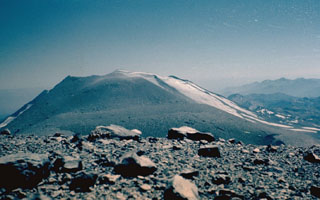Report on Nevados de Chillan (Chile) — 31 January-6 February 2018
Smithsonian Institution / US Geological Survey
Weekly Volcanic Activity Report, 31 January-6 February 2018
Managing Editor: Sally Sennert.
Please cite this report as:
Global Volcanism Program, 2018. Report on Nevados de Chillan (Chile) (Sennert, S, ed.). Weekly Volcanic Activity Report, 31 January-6 February 2018. Smithsonian Institution and US Geological Survey.
Nevados de Chillan
Chile
36.868°S, 71.378°W; summit elev. 3180 m
All times are local (unless otherwise noted)
Servicio Nacional de Geología and Minería (SERNAGEOMIN) Observatorio Volcanológico de Los Andes del Sur (OVDAS) reported that growth of the lava dome in Nevados de Chillán’s Nicanor Crater was 2,540 m3/day, determined by photos taken during overflights on 23 and 31 January. The total volume of the lava dome was an estimated 106,700 m3. A small area of deposits from collapses of the dome walls was observed. Temperatures on the surface of the dome were 305 and 480 degrees Celsius, mainly from a crack which generated the explosions. A larger explosion from a possible partial dome collapse was recorded at 1202 on 2 February, generating a gas-and-ash plume that rose about 2.5 km above the crater rim. Shock waves from the explosion were reported in the community of Las Trancas (10 km) and at the Gran Hotel Termas de Chillan (5 km). Explosive activity continued through 6 February. The Alert Level remained at Yellow, the middle level on a three-color scale, and the public was reminded not to approach the craters within a 4-km radius.
Geological Summary. The compound volcano of Nevados de Chillán is one of the most active of the Central Andes. Three late-Pleistocene to Holocene stratovolcanoes were constructed along a NNW-SSE line within three nested Pleistocene calderas, which produced ignimbrite sheets extending more than 100 km into the Central Depression of Chile. The dominantly andesitic Cerro Blanco (Volcán Nevado) stratovolcano is located at the NW end of the massif. Volcán Viejo (Volcán Chillán), which was the main active vent during the 17th-19th centuries, occupies the SE end. The Volcán Nuevo lava-dome complex formed during 1906-1945 on the NW flank of Viejo. The Volcán Arrau dome complex was then constructed on the SE side of Volcán Nuevo between 1973 and 1986, and eventually exceeded its height. Smaller domes or cones are present in the 5-km valley between the two major edifices.
Source: Servicio Nacional de Geología y Minería (SERNAGEOMIN)

